‘A great miracle’: How The Open conquered political division to return to Royal Portrush
Special report: First Minister Arlene Foster, Head of the Civil Service David Sterling, former Lord Mayor of Belfast Mairtin O’Muilleoir and more reveal a decade-long process that has overcome political and religious division, resentment and grief

Your support helps us to tell the story
From reproductive rights to climate change to Big Tech, The Independent is on the ground when the story is developing. Whether it's investigating the financials of Elon Musk's pro-Trump PAC or producing our latest documentary, 'The A Word', which shines a light on the American women fighting for reproductive rights, we know how important it is to parse out the facts from the messaging.
At such a critical moment in US history, we need reporters on the ground. Your donation allows us to keep sending journalists to speak to both sides of the story.
The Independent is trusted by Americans across the entire political spectrum. And unlike many other quality news outlets, we choose not to lock Americans out of our reporting and analysis with paywalls. We believe quality journalism should be available to everyone, paid for by those who can afford it.
Your support makes all the difference.July 19th, 2011 – With valleys under his eyes betraying the previous night’s sleepless pandemonium, Darren Clarke strolled out onto the 18th green at Royal Portrush Golf Club with reddened cheeks reflected in the Claret Jug and a grin that stretched halfway back to Sandwich.
Forty-eight hours after his improbable Open Championship win, aged 42, this was the “homecoming” leg of Clarke’s lavishly inebriated victory lap and a cramped mass of almost 1,000 local fans crooned and hoisted any debris worthy of signature in his direction.
“This is the best golf course in the world,” Clarke declared. “This golf course is fit to hold any competition in the world.” Little could Clarke have imagined that the “miracle” behind The Open’s return would become something that transcended sport entirely.
***
This isn’t the first time an Open Championship has arrived in Royal Portrush. When Max Faulkner, an equally well-liquored enigma won golf’s oldest major in 1951 after a winter spent milking cows to strengthen his palms, it was the first time the tournament had left England and Scotland.
A remote, idyllic sanctuary built across a mile-long peninsula in North Antrim surrounded by an unfurling labyrinth of dunes, Portrush’s revered Dunluce Links was supposed to become a cherished staple of the Open rota. But as Northern Ireland was consumed by sectarian civil war, blockaded by border checks, with bombs erupting on a near day-by-day basis, the holy grail of tourism was swept into the doldrums.
In 1985, nine years after a series of bombs burnt buildings along the main street, two years before a pair of patrolling Royal Ulster Constabulary officers were shot on the same cobblestones, only one American three-ball dared make the transatlantic visit to the course. The fifth green was in danger of being swallowed by the Irish Sea and the club took in just £35,000 for the entire year. The prospect of any major sporting event returning to Northern Ireland, let alone a high-profile golf event to the diminutive town, was obsolete.
***
As Clarke paraded the Claret Jug around Portrush, three separate groups mapped out blueprints from the fringes. The most ubiquitous of the trio featured Graeme McDowell and Rory McIlroy. Back-to-back US Open winners in 2009 and 2010, McDowell was born and raised in the town, while McIlroy was taught on its links and propelled to stardom when he broke the course record while just 16 years old. Together, they carried a swaying power impossible to silence.
The second group was comprised of Portrush’s three-person sub-committee. Wilma Erskine, the club’s fiercely determined secretary, its chairman, John Bamber, and captain, Philip Tweedie, had already spent the past two years envisioning a strategy to bring The Open back to Northern Ireland.
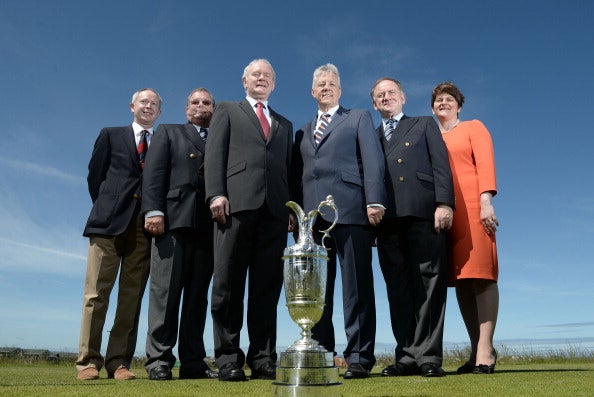
And, right at the back, shielded from the mayhem, Deputy First Minister Martin McGuinness soaked in the strange scene. It was the Sinn Fein leader and former IRA member’s first visit to the town and first time ever setting foot in a royal club. Alongside him, First Minister Peter Robinson and Minister for Enterprise, Trade and Investment, Arlene Foster, beamed in a rare picture of partisan politics standing arm-in-arm. “Martin McGuinness came up to Portrush on a number of occasions,” Foster tells The Independent. “Being a divided society, you can only deliver an event of this scale if you have the support of everyone.”
“He realised bringing The Open to Portrush wasn’t about golf at all,” adds Mairtin O’Muilleoir, one of the late politician’s confidantes who was frequently dispatched to the town on his behalf. “The real prize was trying to create a reconciled, peaceful country and show the world this is a place which can be transformed.”
***
“Don’t let anyone tell you a recession is always bad news,” Bamber says dryly.
Three years before the Good Friday agreement of 1998 was signed, with the embers of tribal tension flickering and the emergence of a fragile peace, Erskine persuaded the R&A to bring the Senior Open Championship back to Portrush and a sleeping giant was reawakened. Arnold Palmer, Tom Watson and Gary Player all left singing songs of virtue but, to take the first stride towards The Open’s return, the committee couldn’t just rely on the pulling-power of players, they needed hard evidence.
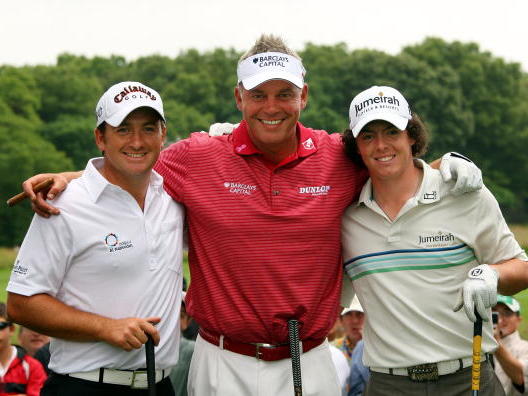
Since the height of The Troubles, the Irish Open had been played exclusively in the Republic. But with the economy strangled by the aftershocks of civil war, business interest sparse and the number of high-profile sponsors dwindling, the Irish government were hesitant to finance the tournament. Sensing opportunity, Erskine tentatively approached the European Tour, IMG and the R&A to ask what it would take to bring the Irish Open back up north.
“Come back to us when you have something close to £1.5-2m,” came the response.
Without the support of banks or business, the committee reintroduced themselves to the politicians who’d lined the fairway on that blustery July day. And, in a room of Portrush’s clubhouse, Erskine laid out her plan to Arlene Foster and representatives of North Antrim and explained the benefits the Irish Open could bring not only to the club but the country. “She was was very positive about the idea,” Erskine says. “She told us to go forward and go get that event.”
Both strong-willed leaders, Erskine and Foster struck up a shared respect that would become a driving force behind The Open’s return for nearly a decade. “Wilma is very much like myself,” Foster says. “If she decides she’s going to put her hand at something, she goes for it. I believed it was possible because there was a real determination to deliver it. The partnership that developed between Portrush and my department was very strong.”
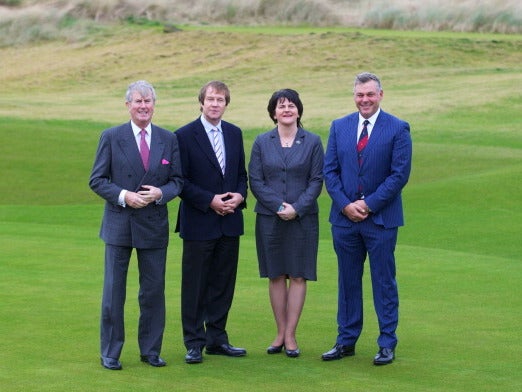
With Foster’s backing, David Sterling, now Head of the Civil Service, brought together the Northern Ireland Tourism Board and all the necessary government agencies required to put on an event of the Irish Open’s magnitude.
“A lot of people would’ve said there was no chance of getting the Irish Open back north,” Sterling says. “At the time, the people who were saying that were probably quite right. I always thought it was a huge stretch and, frankly, I doubted if we’d be able to do so.”
The committee had gained the support and financial backing of the Executive, but the European Tour was still wary of any possible political repercussions from bringing the event back to Northern Ireland for the first time in 65 years. So Erskine and Bamber journeyed to Dublin with their proposal and refused to leave without a signature. Without money for argument, Prime Minister Enda Kenny begrudgingly obliged.
The week before Christmas, the committee received confirmation from the European Tour that the 2012 Irish Open would be staged at Royal Portrush. “We were euphoric,” Bamber gushes. “But after someone cracked open a glass of something bubbly, it dawned on us: we only had six months to put this event on.”
***
Billowing storms left the Dunluce Links sodden and the 2012 Irish Open wrapped in an overcast glare, but the tournament’s return to Northern Ireland was an indisputably beaming success. With Clarke, McIlroy and McDowell effusing praise down the barrel of every microphone, it became the first regular European Tour tournament to ever sell out – in total, 126,505 people attended during tournament week – and that figure that has not come remotely close to being surpassed since.
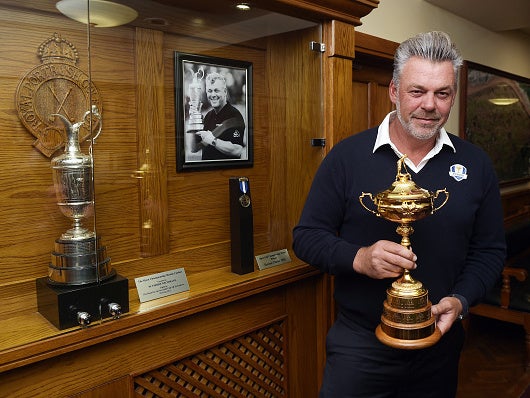
“The Irish Open was a huge success,” Foster says. “It sold out despite the weather and all the logistics worked very well, from policing to transport to the local council. I think some people at the R&A had a disbelief we could deliver. The fact it went so well gave us the evidence base to make the step forward and try to host The Open again.”
“There was a really strong bond behind the tournament between all the government parties,” Sterling adds. “Everyone recognised how important this would be, not just economically or for tourism, but politically. It was the sign of a new and more confident Northern Ireland and that’s when the R&A really started to take the idea of bringing back The Open seriously.”
After the tournament, Foster and Erskine invited the head of the R&A, Peter Dawson, for a meeting at Portrush. Initially, doubts still lingered over whether the town could feasibly shoulder the weight of an Open Championship. But, once Dawson arrived, he was “terrifically positive and very determined,” Bamber says. “But he said ‘if you’re going to host The Open, you’re going to have to change the Dunluce Links in a significant way.
“At that point, I’ve got to be honest, I thought it was a bridge too far.”
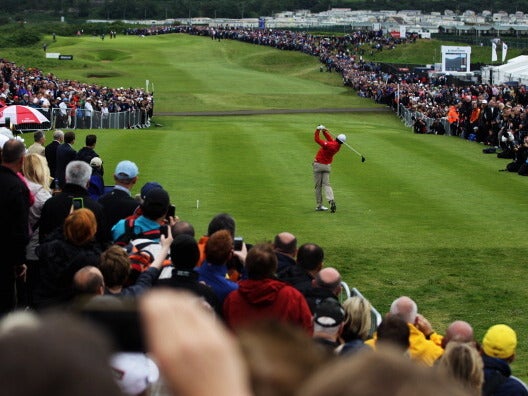
The R&A had given Portrush provisional approval to host the 2019 Open Championship, but only on the condition that the course was reconfigured so there was space for a looming amphitheatre of a grandstand surrounding the 18th green as well as a sprawling commercial tented village.
In October 2014, the club’s members gathered to hear the proposal. Two holes from the neighbouring Valley Links would be absorbed into the course as the 6th and 7th holes, while the old 17th and 18th would be discarded. Further subtle alterations would have to be made to “virtually every single hole” to stretch its sinew to measure well over 7,000 yards.
From members to sponsors, stakeholders and officials, so many people descended on the clubhouse for the meeting that it had to be moved at the last moment to a nearby hotel. “If you’d asked me a few days before how it would pan out, I’d have been very pleased with two-thirds in favour,” Bamber says. Instead, a unanimous sea of arms were raised in approval. After over half a decade of legwork and over half a century of waiting, The Open was officially returning to Royal Portrush.
***
Mairtin O’Muilleoir, 58th Lord Mayor of Belfast and now Finance Minister, stepped out of the car and laid eyes on sunlit Portrush for the first time at 57 years old. “I was gobsmacked,” he laughs. “I thought it was a Blackpool with caravan parks, but it’s spectacularly beautiful.”
Since first standing as a Sinn Fein candidate in 1985, O’Muilleoir had never once considered visiting the holiday town renowned for its royal course. “When I grew up, it would be unimaginable that I’d travel to Portrush, be greeted by a DUP minister and squired around the town,” he says. “But that’s what Martin [McGuinness] wanted, that we could walk together for the common good.”
To create the infrastructure required to host The Open, £17m needed to be injected into Portrush. The buildings had become tired, the roads were too narrow in part, the train station was unable to withstand any mass arrivals, while hotels hardly outnumbered lighthouses. Aside from the course alterations, all the infrastructure for the event – from the grandstands right down to the scoreboards and all other conspicuous tassels – would need to be shipped across the Irish Sea. A new underground sewage system needed to be installed while vistas of grass would have to ripped up to lay a maze of fibre-optic cables.
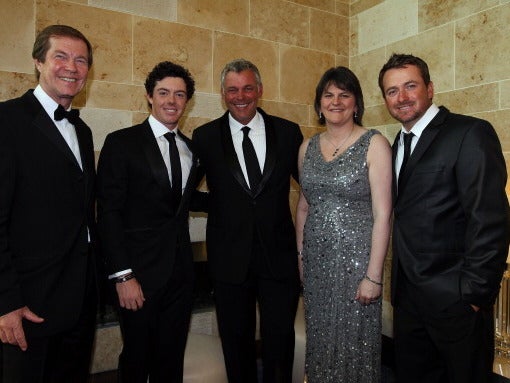
“It was always a murder pitch,” O’Muilleoir says. “It came out of left field, it was money we didn’t have and were already struggling with extremely tough budgets. It can be hard to find £200,000, at a push £1m, but we managed to move things around and perform some accounting magic.”
Between government and the R&A, the town has been manicured right down to the Hollywood Hills-style sign that adorns the seafront. The new station fires trains back-and-forth from nearby Coleraine, over 120 shops have been fitted with new signage and brushed with a fresh gloss of paint, plumes of flowers line the roads and stencil graffiti of the town’s favourite sons lean against the walls. Only the last sniffs of a pub’s stale ale have survived.
“I don’t think the town has looked better in 40 to 50 years,” Bamber says. “Whether you’re a shopkeeper or a hotel owner, everybody has got a lift. It’s the biggest event to come to Northern Ireland in the last 50-100 years.”
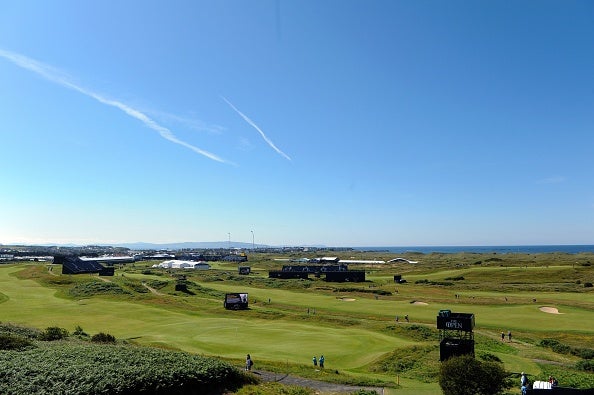
“A lot of money has gone into the town and it has really benefited,” Foster adds. “It’s nice to see something delivered that you started working on way back. I’ll be very pleased and very proud when I’m in the grandstand on Open Sunday.”
Tickets for The Open sold out in record time. Over 215,000 people are expected to make the trip to Northern Ireland, while over 50 per cent are arriving from overseas and bringing the prospect of lasting tourism with them. It’s estimated that £85m will be brought back into the community as a result and two more Championships will be staged at the course as part of its deal with the R&A.
“The R&A took a gamble to come here,” Erskine says. “Would we get the crowds? Fastest selling Open Championship. Would the sponsors come? Corporate hospitality? So far, we’ve ticked all the boxes.”
“Golfers from Cork to Kerry to Wixford to Waterford to Donegal to every county in Northern Ireland, they’re going to be here. If they’re going to have to walk to get here, they’ll do it,” Bamber chimes proudly. “Take me back to 2009 and I would’ve said this is more of a pipe dream than a reality. I still find it quite staggering that every time we asked a question and rolled a dice it kept coming up in our favour.”
***
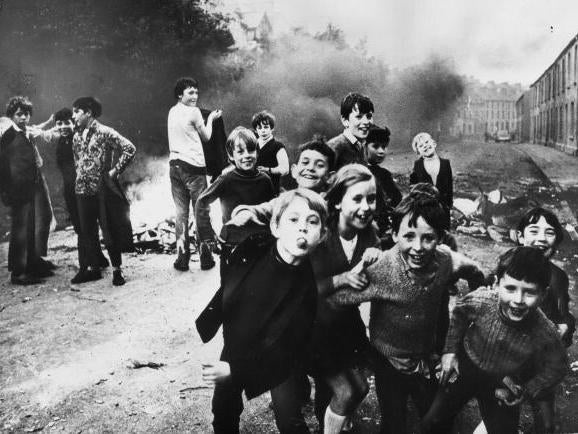
Last Friday the 12th of July, Northern Ireland woke to the banging of drums and an aroma of smoke as the outline of hundreds of pyres raged at dawn. A young boy, no older than nine or 10, walked through the streets of East Belfast with a Union Jack shaved into his hair. In total, 30,000 members of the Orange Order marched across 18 towns to the tune of 700 bands to celebrate the anniversary of the Battle of Boyne – the harbinger of Protestant ascendance 329 years ago.
In Northern Ireland, religion and politics dictate a delicately wrapped peace that can break in an instant. At the height of The Troubles, the Orange marches – known simply as The Twelfth – were a catalyst for riots and paramilitary violence, marked by the burning of tricolour flags and effigies of the Pope. In recent years, as the parades have crossed through nationalist-majority areas, agitation has bled into violence.
Less than three months ago, 35 miles from Portrush, a police sweep in Derry incited a riot and 29-year-old journalist Lyra McKee was caught in the crossfire as a masked gunman, believed to be a member of the New IRA, fired 12 bullets towards the police.
Brexit and the prospect of a hard border continue to stoke sectarian division and the country has been without a sitting government for over two years since the Executive collapsed in January 2017. Soon, the number of Irish Catholics will outnumber Protestants and the country could feasibly vote to join a united Ireland as permitted by the Good Friday agreement.
So, perhaps, the greatest miracle of The Open’s belated return to Portrush isn’t the unthinkable investment and tireless effort, nor that three major winners from a population of just 1.6m are sharing the same era. In fact, it might not be anything to do with golf at all. The greatest triumph of The Open is that, even for only a brief moment, political and religious division, resentment, grief and even hatred have been diffused and united. The obstacle all those involved, from politicians, to the committee to the R&A, never believed was possible to overcome.
“For anyone who lived through the years I lived through, every day of this fragile peace, this difficult time, is miraculous,” O’Muilleoir says. “With all due respect to those who worship at golf’s altar, it’s not about sport at all. It’s the hope that moments like these give people pause for reflection. To understand the power of when we come together; that then nothing is impossible. This Open is a part of that great miracle.”
Join our commenting forum
Join thought-provoking conversations, follow other Independent readers and see their replies
Comments